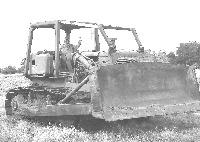- Posts: 478
- Thank you received: 67

ACMOC Membership Benefits
- FREE quarterly magazine filled with content about antique Caterpillar machines
- FREE classified listings
- ACMOC store discounts and specials
- Full Bulletin Board Access
- Marketplace (For Sale/Wanted)
- Technical Library
- Post attachments
$44 /year ELECTRONIC
$60 /year USA
$77 /year International
Pro's and Cons of LGP Undercarriage
-are there any benefits to wider shoes other than lower ground pressure to work in soft,swampy ground?
- currently have the 30" shoes and have been thinking of trimming them down to the standard 24" shoe (D6c)
-have no intentions of operating in swamps...
is it a good idea or bad idea? interested in your thoughts and experiences, thanks
Greatest Lie told to mankind: just give us 2 weeks to flatten the curve!
Please Log in or Create an account to join the conversation.
Please Log in or Create an account to join the conversation.
Greatest Lie told to mankind: just give us 2 weeks to flatten the curve!
Please Log in or Create an account to join the conversation.
Trimming the pads is a bigger project than you think, unless the undercarriage in really great condition I don't know if any gain you would achieve would be worth the effort of the trim job.
The easy fix is to adjust your operating procedure to avoid sharp turns and rough terrain until it's time to replace tracks.
The wider pads are nice for snow. You might regret the trim in winter.
Craig
Please Log in or Create an account to join the conversation.
Please Log in or Create an account to join the conversation.
-yes it's a big job for how much benefit, that's the dilemma...is it really worth the time and trouble...?
Greatest Lie told to mankind: just give us 2 weeks to flatten the curve!
Please Log in or Create an account to join the conversation.
Still a tough call as to weather the potential gain is worth the effort.
Craig
Please Log in or Create an account to join the conversation.
-oxy-acetylene
-big plasma cutter
-mechanical band saw of some kind
-other?
Greatest Lie told to mankind: just give us 2 weeks to flatten the curve!
Please Log in or Create an account to join the conversation.
Please Log in or Create an account to join the conversation.
- ironman3406
-

- Offline
- Administrator
- Member
- Posts: 242
- Thank you received: 25
The standard gauge D6C is 74” and the standard pad width as you can see by this chart was 18”. And had optional widths up to 24”
The LGP gauge D6C is 83” with a track pad width of 36”. That means the track frames were spaced out an additional 4.5” on each side to allow the wider pads for better floatation.
If you truly want to narrow your track pads I wouldn’t go any narrower than 24” personally, you never know when you might be in a situation where that little extra width gets you out of a bind. You can see that a standard gauge D6C with the 18” pads has almost double the ground pressure as the full LGP gauge tractor. So you do gain floatation as the pads get wider.
I think the best option for cutting them is oxy/acetylene, just give yourself a nice straight edge to follow and cut equal amounts off each side of the pad. Don’t just cut off one side like I’ve seen others do, otherwise you still have the same problem on the original width side of the pad.
Yes wide pads can cause premature wear in undercarriage because of the extra stress that can be added by hard uneven terrain. What kind of work do you plan to do? How often will you be in softer conditions? Are you working in lots of big rock? These are the questions I’d consider before cutting to narrow.
The other option is you could watch for a set of narrower pads to come up for sale and swap the pads out rather than torch cutting them and potentially weakening the metallurgy of the steel from the heating and cooling process.
Hope this is of something use,
Nathan
Nathan Duncan
Attachments:
Please Log in or Create an account to join the conversation.
ACMOC
Antique Caterpillar Machinery Owners Club
P.O. Box 9301
Peoria, IL 61612
(309) 691-5002
cat@acmoc.org
"I became a member recently because the wealth of knowledge here is priceless."
- Chris R
"I also joined a year ago. had been on here a couple of times as a non-member and found the info very helpful so I got a one year subscription (not very expensive at all) to try it out. I really like all the resources on here so I just got a three year. I think its a very small price for what you can get out of this site."
- Jason N




